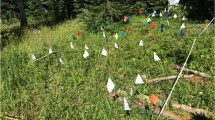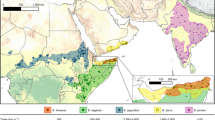Abstract
Echinacea angustifolia DC. (Asteraceae) is a major North American medicinal plant that has been harvested commercially in north-central Kansas for 100 years, making it one of the longest documented histories of large-scale commercial use of a native North American medicina herb. We have compiled historical market data and relate it to harvest pressure on wildEchinacea populations. Interviews with local harvesters describe harvesting methods and demonstrate the species’ resilience. Conservation measures forE. angustifolia also should address the other threats faced by the species and may include restoration and management of its mixed-grass prairie habitat and protection by private landowners.
Similar content being viewed by others
Literature Cited
American Herbal Products Association. 2003. Tonnage survey of North American wild-harvested plants, 2000-2001. American Herbal Products Association, Silver Spring, MD.
Anderson, M. K. 1993. Native Californians as ancient and contemporary cultivators. Pages 151–174 in T. C. Blackburn and M. K. Anderson, eds., Before the wilderness: Environmental management by native Californians. Ballena Press, Menlo Park, CA.
—. 1997. From tillage to table: Indigenous cultivation of geophytes for food in California. Journal of Ethnobiology 17(2):149–169.
Bailey, Brent. 1999. Social and economic impacts of wild harvested products. Ph.D. dissertation, College f Agriculture, Forestry and Consumer Sciences, West Virginia University, Morgantown, WV.
Bartholomew, David M. 1999. Pioneer naturalist on the Plains: The diary of Elam Bartholomew, 1871 to 1934. Sunflower University Press, Manhattan, KS.
Baskauf, Carol J. and William G. Eickmeier. 1994. Comparative ecophysiology of a rare and a widespread ecies ofEchinacea (Asteraceae). American Journal of Botany 81(8):958–964.
Binns, Shannon E., Bernard R. Baum, and John T. Arnason. 2002. A taxonomic revision ofEchinacea(Asteraceae: Heliantheae). Systematic Botany 27:610–632.
Blumenthal, Mark. 2000. Market report: Herb sales down 3% in mass market retail stores— sales in natural food stores still growing, but at lower rate. HerbalGram 49:68.
—. 2001. Herb sales down 15% in mainstream market. HerbalGram 51:69.
—, Grant Ferrier, and Courtney Cavaliere. 2006. Total sales of herbal supplements in United States show steady growth. HerbalGram 71:64–66.
Boyd, Ruth. 1997. A letter from the Oklahoma native plant society. Kansas Wildflower Society Newsletter 19(3):38–39.
Brevoort, Peggy. 1996. The U.S. botanical market: An overview. HerbalGram 36:49.
—. 1998. The booming U.S. botanical market: A new overview. HerbalGram 44:33–46.
Chapman, Douglas S. and Robert M. Auge. 1994. Physiological mechanisms of drought resistance in four native ornamental perennials. Journal of the American Society for Horticultural Science 119(2):299–306.
Crawford, Glinda. 1998. Purple prairie produce: Herbal sales generate coneflower demand, concern. North Dakota Outdoors 61(1):8–11.
Felter, H. W. 1898. The newer materia medica. I.Echinacea. Eclectic Medical Journal 58:79–89.
Flannery, Michael. 1999. From Rudbeckia toEchinacea: The emergence of the purple cone flower in modern therapeutics. Pharmacy in History 4l(2):52–59.
Foster, Steven. 1991.Echinacea, Nature’s immune enhancer. Healing Arts Press, Rochester, VT.
Fuller, D. O. 1991. Medicine from the wild: An overview of the U.S. native medicinal plant trade and its conservation implications. World Wildlife Fund, Washington, DC.
Gilmore, M. 1977. Uses of plants by the Indians of the upper Missouri region. Reprint of a work first published as Bureau of American Ethnology Thirty-Third Annual Report, Washington, DC, 1919.
Godoy, Ricardo A. and Kamaljit S. Bawa. 1993. The economic value and sustainable harvest of plants and animals from the tropical forest: Assumptions, hypotheses, and methods. Economic Botany 47(3):215–219.
Hobbs, C. 1994.Echinacea: A literature review. HerbalGram 30:33–48.
Hurlburt, D. Price 1999. Population ecology and economic botany ofEchinacea angustifolia, a native prairie medicinal plant. Ph.D. dissertation, Department of Ecology and Evolutionary Biology, University of Kansas, Lawrence, KS.
Johnston, Barbara A. 1997. Whole Foods Magazine’s 2nd annual herb market survey for U.S. health food stores. HerbalGram 40:52.
—. 1998a.Echinacea #1 in natural food trade. HerbalGram 41:53.
—. 1998b. Herb sales up 101% in mainstream market. HerbalGram 43:61.
Joyal, Elaine. 1996. The palm has its time: An ethnoecology ofSabal uresana in Sonora, Mexico. Economic Botany 50(4):446–462.
Kindscher, K. 1989. Ethnobotany of purple coneflower (Echinacea angustifolia, Asteraceae) and otherEchinaceaspecies. Economic Botany 43(4):498–507.
King, J. 1887.Echinacea angustifolia. Eclectic Medical Journal 42:209–210.
Kirk, Thomas, Jr. 1903. Unpublished correspondence to Lloyd Brothers, June 29 and July 24, 1903. Lloyd Library, Cincinnati, OH.
Klein, Robyn. 1999. Friends ofEchinacea: The concern continues to grow. United Plant Savers Newsletter 2(1): 18.
Kolster, Monique K. 1998. Impacts of the globalEchinaceamarket on the people and land of the Fort Peck Assiniboine and Sioux Reservation. MS thesis, University of Montana, Missoula, MT.
Lantz, Gary. 1997. Coneflowers’ popularity: Prescription for trouble? National Wildlife June/July 1997:12–13.
Little, Richard. 1998. GrowingEchinacea angustifolia: Research at SDSU and insights from a grower. Unpublished newsletter, South Dakota State University.
Lloyd, Curtis Gates. 1897-1901. Unpublished correspondence to E. Bartholomew. Lloyd Library, Cincinnati, OH.
Lloyd, John Uri. 1897. Empiricism:Echinacea. Eclectic Medical Journal 57:421–427.
—. 1904. History ofEchinacea angustifolia. American Journal of Pharmacy 76(1):15–19.
-. 1917. A treatise onEchinacea. Lloyd Brothers Drug Treatise no. 30, Cincinnati, OH.
Loring, Hillary, Mike Bullerman, and Kelly Kindscher. 1999. Inventory of the central mixed-grass prairie ecoregion of Kansas and Nebraska. Unpublished report to the Nature Conservancy.
Luddington, John. 1903. Unpublished correspondence to Lloyd Brothers, July 15, 1903. Lloyd Library, Cincinnati, OH.
Lyons Daily News (KS). 1996. Snakeroot in their livelihood. May 29, 1996, p. 9.
McGregor, R. L. 1968. The taxonomy of the genusEchinacea (Compositae). University of Kansas Science Bulletin 48(4):113–142.
McGuffin, Michael. 2001. AHPA’s 1999 tonnage survey measures harvest of 12 plants. American Herbal Products Association AHPA Report, Winter 2001: 11, 17.
Milner-Guland, E. J. and Ruth Mace. 1998. Conservation of biological resources. Blackwell Science, Oxford, UK.
Missouri Department of Transportation 1998. Plant poaching plagues Missouri’s wild places. Native Warm-Season Grass Newsletter 17(2):4–5.
NatureServe. 2005. NatureServe explorer: An online encyclopedia of life [web application]. Version 4.2. NatureServe, Arlington, Virginia. Available at http://www.natureserve.org/explorer [Accessed: May 6, 2005].
Oil, Paint and Drug Reporter. 1910–1941. Drug report: Roots and herbs, wholesale prices current on New York market.
Patton, M. Q. 1990. Qualitative evaluation and research methods. 2nd ed. Sage Publications, Newbury Park, CA.
Richman, A. and J. P. Witkowski. 1996. A wonderful year for herbs. Whole Foods Magazine, October, pp. 52–60.
-. 1999. Whole Foods herbal product sales survey. Whole Foods Magazine, October, pp. 49–56.
Roberts, H. F. 1903. Unpublished correspondence to Lloyd Brothers, June 3 and June 22, 1903. Lloyd Library, Cincinnati, OH.
Robson, C. 1993. Real world research: A resource for social scientists and practitioner-researchers. Blackwell Publishers, Oxford, UK.
Runk, J. Velasquez. 1998. Productivity and sustainability of a vegetable ivory palm (Phytelephas aequatorialis, Arecaceae) under three management regimes in Northwestern Ecuador. Economic Botany 52(2): 168–182.
Sahr, Robert C. 2006. Consumer Price Index (CPI) Conversion Factors 1800 to estimated 2015 to convert to dollars of 2005 [Web site]. Revised 01/18/2006. Available at http://oregonstate.edu/ Dept/pol_sci/fac/sahr/sahrhome.htm [Accessed: April 6, 2006].
Samson, Fred and Fritz Knopf. 1994. Prairie conservation in North America. BioScience 44(6):418–421.
Sayre, L. E. 1897. Therapeutical notes and description of parts of medicinal plants growing in Kansas. Transactions of the Kansas Academy of Science 16:85–89.
—. 1903.Echinacea roots. Transactions of the Kansas Academy of Science 19:209–213.
Trager, James C. 1998. Glorious Glades. Missouri Prairie Journal 19(2):6–7.
Tyler, Varro E. 1986. Plant drugs in the twenty-first century. Economic Botany 40(3):279–288.
Urbatsch, Lowell E., Kurt M. Neubig, and Patricia B. Cox. 2005. Echinacea. Pages 88–92 in Flora of North America Editorial Committee, eds. Flora of North America north of Mexico, vol. 21 of 26. Oxford University Press, New York and Oxford, UK.
U.S. Department of Agriculture Economic Research Service. 2006. County-level unemployment and median household income for Kansas. http://www.ers.usda.gov/Data/Unemployment/RDList2.asp?S T=KS [accessed: 15 December 2006].
Weaver, J. E., L. A. Stoddart, and W. Noll. 1935. Response of the prairie to the great drought of 1934. Ecology 16(4):612–629.
Author information
Authors and Affiliations
Corresponding author
Rights and permissions
About this article
Cite this article
Price, D.M., Kindscher, K. One hundred years ofEchinacea angustifolia harvest in the smoky hills of Kansas, USA. Econ Bot 61, 86–95 (2007). https://doi.org/10.1663/0013-0001(2007)61[86:OHYOEA]2.0.CO;2
Accepted:
Issue Date:
DOI: https://doi.org/10.1663/0013-0001(2007)61[86:OHYOEA]2.0.CO;2




